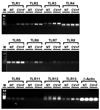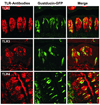Inflammation and taste disorders: mechanisms in taste buds
- PMID: 19686199
- PMCID: PMC2729510
- DOI: 10.1111/j.1749-6632.2009.04480.x
Inflammation and taste disorders: mechanisms in taste buds
Abstract
Taste disorders, including taste distortion and taste loss, negatively impact general health and quality of life. To understand the underlying molecular and cellular mechanisms, we set out to identify inflammation-related molecules in taste tissue and to assess their role in the development of taste dysfunctions. We found that 10 out of 12 mammalian Toll-like receptors (TLRs), type I and II interferon (IFN) receptors, and their downstream signaling components are present in taste tissue. Some TLRs appear to be selectively or more abundantly expressed in taste buds than in nongustatory lingual epithelium. Immunohistochemistry with antibodies against TLRs 1, 2, 3, 4, 6, and 7 confirmed the presence of these receptor proteins in taste bud cells, of which TLRs 2, 3, and 4 are expressed in the gustducin-expressing type II taste bud cells. Administration of TLR ligands, lipopolysaccharide, and double-stranded RNA polyinosinic:polycytidylic acid, which mimics bacterial or viral infection, activates the IFN signaling pathways, upregulates the expression of IFN-inducible genes, and downregulates the expression of c-fos in taste buds. Finally, systemic administration of IFNs augments apoptosis of taste bud cells in mice. Taken together, these data suggest that TLR and IFN pathways function collaboratively in recognizing pathogens and mediating inflammatory responses in taste tissue. This process, however, may interfere with normal taste transduction and taste bud cell turnover and contributes to the development of taste disorders.
Figures



References
-
- Heald AE, Schiffman SS. Taste and smell. Neglected senses that contribute to the malnutrition of AIDS. N. C. Med. J. 1997;58:100–104. - PubMed
-
- Sherry WV. Taste alterations among patients with cancer. Clin J Oncol Nurs. 2002;6:73–77. - PubMed
-
- Wickham RS, Rehwaldt M, Kefer C, et al. Taste changes experienced by patients receiving chemotherapy. Oncol. Nurs. Forum. 1999;26:697–706. - PubMed
-
- Pribitkin E, Rosenthal MD, Cowart BJ. Prevalence and causes of severe taste loss in a chemosensory clinic population. Ann. Otol. Rhinol. Laryngol. 2003;112:971–978. - PubMed
-
- Henkin RI, Larson AL, Powell RD. Hypogeusia, dysgeusia, hyposmia, and dysosmia following influenza-like infection. Ann. Otol. Rhinol. Laryngol. 1975;84:672–682. - PubMed
Publication types
MeSH terms
Substances
Grants and funding
LinkOut - more resources
Full Text Sources
Other Literature Sources
Medical

